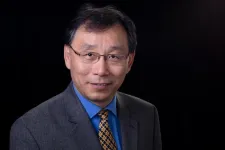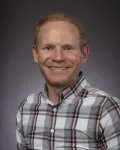(Press-News.org) A multi-university research team co-led by University of Virginia engineering professor Gustavo K. Rohde has developed a system that can spot genetic markers of autism in brain images with 89 to 95% accuracy.
Their findings suggest doctors may one day see, classify and treat autism and related neurological conditions with this method, without having to rely on, or wait for, behavioral cues. And that means this truly personalized medicine could result in earlier interventions.
“Autism is traditionally diagnosed behaviorally but has a strong genetic basis. A genetics-first approach could transform understanding and treatment of autism,” the researchers wrote in a paper published June 12 in the journal Science Advances.
Rohde, a professor of biomedical and electrical and computer engineering, collaborated with researchers from the University of California San Franscisco and the Johns Hopkins University School of Medicine, including Shinjini Kundu, Rohde’s former Ph.D. student and first author of the paper.
While working in Rohde’s lab, Kundu — now a physician at the Johns Hopkins Hospital — helped develop a generative computer modeling technique called transport-based morphometry, or TBM, which is at the heart of the team’s approach.
Using a novel mathematical modeling technique, their system reveals brain structure patterns that predict variations in certain regions of the individual’s genetic code — a phenomenon called “copy number variations,” in which segments of the code are deleted or duplicated. These variations are linked to autism.
TBM allows the researchers to distinguish normal biological variations in brain structure from those associated with the deletions or duplications.
“Some copy number variations are known to be associated with autism, but their link to brain morphology — in other words, how different types of brain tissues such as gray or white matter, are arranged in our brain — is not well known,” Rohde said. “Finding out how CNV relates to brain tissue morphology is an important first step in understanding autism’s biological basis.”
How TBM Cracks the Code
Transport-based morphometry is different from other machine learning image analysis models because the mathematical models are based on mass transport — the movement of molecules such as proteins, nutrients and gases in and out of cells and tissues. “Morphometry” refers to measuring and quantifying the biological forms created by these processes.
Most machine learning methods, Rohde said, have little or no relation to the biophysical processes that generated the data. They rely instead on recognizing patterns to identify anomalies.
But Rohde’s approach uses mathematical equations to extract the mass transport information from medical images, creating new images for visualization and further analysis.
Then, using a different set of mathematical methods, the system parses information associated with autism-linked CNV variations from other “normal” genetic variations that do not lead to disease or neurological disorders — what the researchers call “confounding sources of variability.”
These sources previously prevented researchers from understanding the “gene-brain-behavior” relationship, effectively limiting care providers to behavior-based diagnoses and treatments.
According to Forbes magazine, 90% of medical data is in the form of imaging, which we don’t have the means to unlock. Rohde believes TBM is the skeleton key.
“As such, major discoveries from such vast amounts of data may lie ahead if we utilize more appropriate mathematical models to extract such information.”
The researchers used data from participants in the Simons Variation in Individuals Project, a group of subjects with the autism-linked genetic variation.
Control-set subjects were recruited from other clinical settings and matched for age, sex, handedness and non-verbal IQ while excluding those with related neurological disorders or family histories.
“We hope that the findings, the ability to identify localized changes in brain morphology linked to copy number variations, could point to brain regions and eventually mechanisms that can be leveraged for therapies,” Rohde said.
Publication
Discovering the gene-brain-behavior link in autism via generative machine learning was published June 12, 2024, in Science Advances.
Additional co-authors are Haris Sair of the Johns Hopkins School of Medicine and Elliott H. Sherr and Pratik Mukherjee of the University of California San Francisco’s Department of Radiology.
The research received funding from the National Science Foundation, National Institutes of Health, Radiological Society of North America and the Simons Variation in Individuals Foundation.
END
UVA research cracks the autism code, making the neurodivergent brain visible
Model grounded in biology reveals the tissue structures linked to the disorder
2024-08-28
ELSE PRESS RELEASES FROM THIS DATE:
Marine engineering group to award ORNL researchers for innovative welding software
2024-08-28
Zhili Feng, a distinguished R&D staff member, and Jian Chen, a senior R&D staff member, in Materials Science and Technology Division at the Department of Energy’s Oak Ridge National Laboratory, will receive the Elmer L. Hann Award at the Society of Naval Architects and Maritime Engineers, or SNAME, Convention on Oct. 15 in Norfolk, Virginia. SNAME plays a crucial role in promoting excellence in marine engineering and naval architecture, supporting professionals through education, research and collaboration.
The award is presented to authors of the best paper on ship production delivered at a SNAME event. In September 2023, Feng and Chen presented “Develop ...
UBC engineers develop all-in-one solution to catch and destroy ‘forever chemicals’
2024-08-28
Chemical engineers at the University of British Columbia have developed a new treatment that traps and treats PFAS substances—widely known as “forever chemicals”—in a single, integrated system.
Per- and polyfluoroalkyl substances (PFAS) are widely used in manufacturing consumer goods like waterproof clothing due to their resistance to heat, water and stains. However, they are also pollutants, often ending up in surface and groundwater worldwide, where they have been linked to cancer, liver damage and ...
Purdue researchers take inspiration from viruses to improve delivery of nucleic acid-based therapies to cancer cells
2024-08-28
WEST LAFAYETTE, Ind. — A researcher in Purdue University’s College of Science is developing a patent-pending platform technology that mimics the dual-layer structure of viruses to deliver nucleic acid (NA)-based therapies to targeted cancer cells.
David Thompson leads a team developing the carrier system called LENN. He is a professor in the James Tarpo Jr. and Margaret Tarpo Department of Chemistry and on the faculty of the Purdue Institute for Cancer Research and the Purdue ...
New USC research reveals untapped potential for mobilizing voters of color in battleground states
2024-08-28
With swing states playing a pivotal role in the 2024 presidential election, new reports from the Center for Inclusive Democracy (CID) at the USC Sol Price School of Public Policy have found significant voter turnout disparities between white, non-Latino voters and voters of color in all nine battleground states.
The reports highlight the persistent “voter representation gap,” where voters of color remain underrepresented at the polls, despite substantial population growth. If narrowed by November, the research concludes, this gap could significantly influence election results, particularly in swing states that had particularly close ...
The Public Health Career Explorer launches, matching health department job openings with career interests and preparation
2024-08-28
August 28, 2024-- A new, easy-to-use, evidence-based career assessment, the Public Health Career Explorer, has just launched to help job-seekers who are interested specifically in public health careers.
The Public Health Career Explorer career assessment tool, three years in the making, was developed at Columbia University Mailman School of Public Health. Using the well-researched O*Net MyNextMove assessment, Columbia Mailman School’s Heather Krasna, PhD, EdM, MS, associate dean of career and professional development painstakingly matched the Holland Codes (career interest codes) for each of the specific ...
How stigma affects Asian Americans living with hepatitis B
2024-08-28
Asian Americans comprise just 6% of the U.S. population, but they represent over 60% of Americans with hepatitis B. Hepatitis B (HBV) is a virus that infects the liver, and while some people may recover from the infection, others can go on to develop liver failure or cancer. HBV is transmitted through blood, semen or other bodily fluids, but it can also be passed from mother to child during birth, which is how the majority of Asian Americans acquire the disease.
Up until 2010, laws in China allowed for discrimination against people with HBV, barring adults from employment and keeping ...
New study: drug may stop migraines before headache starts
2024-08-28
MINNEAPOLIS – When taken at the first signs of a migraine, before headache pain begins, a drug called ubrogepant may be effective in helping people with migraine go about their daily lives with little or no symptoms, according to a new study published in the August 28, 2024, online issue of Neurology®, the medical journal of the American Academy of Neurology. The study focused on people with migraine who could tell when an attack was about to happen, due to early symptoms such as sensitivity to light and sound, fatigue, neck pain or stiffness, or dizziness.
Ubrogepant ...
Using high resolution mass spectrometry to study fuel chemistry
2024-08-28
WASHINGTON – U.S. Naval Research Laboratory researcher Mark Romanczyk, Ph.D., developed new analytical methods to rapidly analyze fuels and complex petroleum products by using high-resolution mass spectrometry.
The approaches Romanczyk utilizes enable highly detailed qualitative analysis of complex mixtures in minutes. One recent method facilitated the investigation of chemical changes that occurred in weathered crude oil in terrestrial environments. Several of the methods were recently published in the ...
Dartmouth’s Geisel School of Medicine to launch new online Master’s Degree program in Implementation Science
2024-08-28
Preview blurb: Geisel’s new fully online 9-month MS in Implementation Science will give graduates the skills to identify and address gaps in moving evidence-based clinical practices into routine use in the real world.
HANOVER, NH - “How can we more quickly and effectively move new, proven scientific evidence into routine healthcare practice? What obstacles must be overcome to embrace change and modify behavior? How can we scale a successful intervention so that more people will benefit?”
These are some of the key questions future students will learn to tackle as enrollees ...
Houston Methodist and Rice University Center for Neural Systems Restoration Inaugural Fall Symposium
2024-08-28
World-renowned physicians and scientists will gather at the Houston Methodist Research Institute September 17-18 to discuss pioneering research discoveries and technologies in neuroscience that have the potential to transform the field and evolve into innovative treatments for neurological disorders of all kinds.
Hosted by the Houston Methodist and Rice University Center for Neural Systems Restoration, the symposium brings together experts in the field of neural circuits, neural technology and neuro-restoration. Twenty-four speakers will highlight the ...
LAST 30 PRESS RELEASES:
Numbers in our sights affect how we perceive space
SIMJ announces global collaborative book project in commemoration of its 75th anniversary
Air pollution exposure and birth weight
Obstructive sleep apnea risk and mental health conditions among older adults
How talking slows eye movements behind the wheel
The Ceramic Society of Japan’s Oxoate Ceramics Research Association launches new international book project
Heart-brain connection: international study reveals the role of the vagus nerve in keeping the heart young
Researchers identify Rb1 as a predictive biomarker for a new therapeutic strategy in some breast cancers
Survey reveals ethical gaps slowing AI adoption in pediatric surgery
Stimulant ADHD medications work differently than thought
AI overestimates how smart people are, according to HSE economists
HSE researchers create genome-wide map of quadruplexes
Scientists boost cell "powerhouses" to burn more calories
Automatic label checking: The missing step in making reliable medical AI
Low daily alcohol intake linked to 50% heightened mouth cancer risk in India
American Meteorological Society announces Rick Spinrad as 2026 President-Elect
Biomass-based carbon capture spotlighted in newly released global climate webinar recording
Illuminating invisible nano pollutants: advanced bioimaging tracks the full journey of emerging nanoscale contaminants in living systems
How does age affect recovery from spinal cord injury?
Novel AI tool offers prognosis for patients with head and neck cancer
Fathers’ microplastic exposure tied to their children’s metabolic problems
Research validates laboratory model for studying high-grade serous ovarian cancer
SIR 2026 delivers transformative breakthroughs in minimally invasive medicine to improve patient care
Stem Cell Reports most downloaded papers of 2025 highlight the breadth and impact of stem cell research
Oxford-led study estimates NHS spends around 3% of its primary and secondary care budget on the health impacts of heat and cold in England
A researcher’s long quest leads to a smart composite breakthrough
Urban wild bees act as “microbial sensors” of city health.
New study finds where you live affects recovery after a hip fracture
Forecasting the impact of fully automated vehicle adoption on US road traffic injuries
Alcohol-related hospitalizations from 2016 to 2022
[Press-News.org] UVA research cracks the autism code, making the neurodivergent brain visibleModel grounded in biology reveals the tissue structures linked to the disorder






